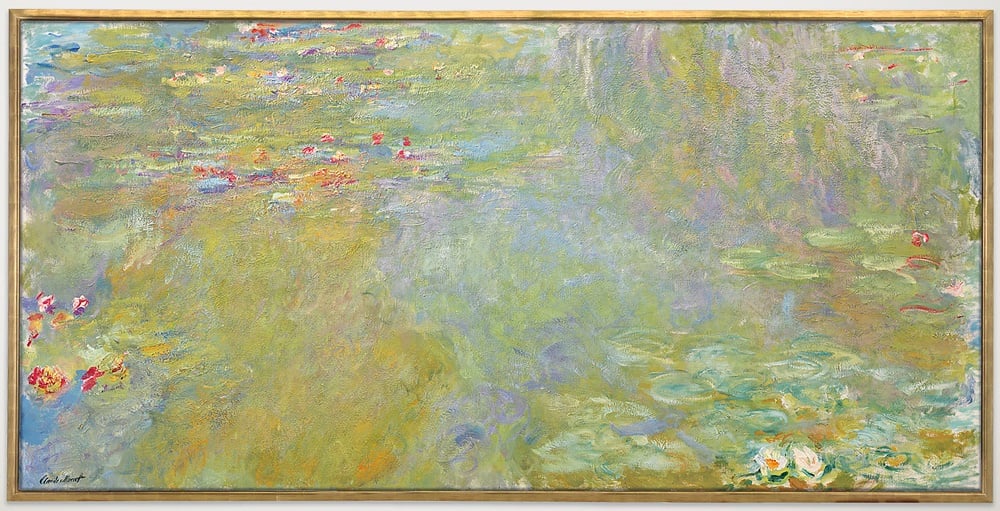Auctions
Take a 100-Year Trip Through Art History With Claude Monet’s Monumental Water Lily Painting
The story of this Monet water lily painting starts 100 years ago with the 1918 Armistice.

The story of this Monet water lily painting starts 100 years ago with the 1918 Armistice.

Eileen Kinsella

![]()
The upcoming fall auction season in New York has a plethora of treasures—seemingly even more than usual. In recent weeks, major auction houses have been rolling out a steady stream of blockbuster consignments, many hailing from the estates of prestigious collectors.
One of the standouts, coming up at Christie’s evening sale of Impressionist and modern art on November 11, is the monumental water lily painting Le bassin aux nymphéas (1917–19) by Claude Monet. The four- by six-and-a-half-foot canvas will undoubtedly will make headlines if it hits its lofty $30 million to $50 million estimate. If it meets the high expectation, it will fall within the top 10 works by Monet ever sold at auction.
“It’s interesting to see the important hands that this painting has passed through,” said Jessica Fertig, Christie’s head of Impressionist and modern evening sales for New York. “Monet was purposely working on this larger scale for grand decoration. These larger ones are rare to the market.”
The painting offers a fascinating case study in how one work can wend its way through major collections over the course of a century.
Nearly a century ago to the day—on November 12, 1918, the day after the signature of the Armistice that ended the First World War—Monet decided that he would create what he described as a monument to peace. This involved creating a set of large water lily paintings inspired by the water garden that he created at his Giverny estate in Normandy, which he would dedicate to France.
French Prime Minister Georges Clemenceau readily agreed to the proposal and planned for the works to go on display in the Orangerie Museum, inside the Tuileries Gardens in Paris. Eight works were installed there soon after Monet’s death in 1926 at the age of 86. There, they still hang today.

The interior of Musée de l’Orangerie in Paris, France. Photo by Jason7825. Image courtesy Wikimedia Commons.
The majority of these late Monet Nymphéas, however, remained with the artist’s descendants for another 25 years or so, according to Christie’s. “It was only after the Second World War that contemporary audiences, schooled in Abstract Expressionism, came to recognize the greatly daring poetry of these huge, valedictory paintings,” the catalogue explains.
This canvas, created between 1917 and 1919, was one of several passed to Michel Monet, the artist’s younger son, after the painter passed away. It was part of an important group that Paris dealer Katia Granoff selected from Monet’s studio starting in 1955.
Through the Fairweather Hardin Gallery in Chicago, it was bought in 1959 by Grant J. Pick, a major benefactor of the Art Institute of Chicago at the time. He donated the work to the Art Institute of Chicago—but it didn’t remain in the public collection for long. In April 1965, the museum opted to sell the painting, among several other major works it sold in the ’60s, at Parke-Bernet, the New York auction house that was eventually purchased by Sotheby’s.
At the Parke-Bernet sale, the work was bought by Washington, DC, collector David Lloyd Kreeger, who had made his fortune as CEO of Geico Insurance Company and was well known as an arts patron. (His collection is now housed at the Kreeger Museum in Washington.)
Kreeger held on to the work for about a decade, before selling to it to another prestigious collector, Ernst Beyeler, founder of Basel’s Galerie Beyeler, in 1976. After multiple moments in its history when it might have ended up on public view, however, the work disappeared into a more private collection again, this time in Switzerland. It remained there until 2000, when it was auctioned at Christie’s New York.
This most recent sale provides the first publicly recorded benchmark of value. According to the artnet Price Database, Christie’s offered the work with an estimate of $9 million to $12 million. It sold for well under that, at a final price of $6.8 million. Clearly, the auction house believes the market for Monet is much stronger now, with demand from wealthy buyers in Asia and the Middle East playing such a large role in the current global art market. (It remains to be seen whether the current economic strain in China will put a damper on the final price.)
An unidentified private collection was the buyer at the 2000 Christie’s sale. The work next came up for sale at New York’s Acquavella Galleries. It was there that the present consignor acquired it in 2002.
The Monet has been shown in many museum shows over the years, from the Metropolitan Museum of Art (1966) to Munich’s Kunsthalle der Hypo-Kulturstiftung (2001-2002). And it continues to be part of the artist’s story: the Fine Arts Museums of San Francisco and the Kimbell Art Museum in Fort Worth have already requested it for the upcoming “Monet: The Late Years,” opening next year. A century on, the painting still has new stories to tell.